I love farms and farming. Even when it is cold and rainy, or extremely hot and mosquito-ey, I am reminded of some words MaryJane shared with me once: It is so much better to be stuck working outside during less-than-desirable weather than to be stuck working inside on a beautiful day.
Sometimes I REALLY have to remind myself of this great insight, but I usually come around, even in the thickest of mosquitos.
Visiting farms around my community, state, country and world is one of my favorite things to do. I have dreams of one day visiting South America, Europe, Australia, Southeast Asia, Australia, India, Africa (the whole world, really) and trekking from farm to farm, getting to see the different farming methods. It would be especially fun to see how similar or diferent the ubiquitous potato is planted, grown and stored the world over…
Anyhow, I’ve been back in Alaska for two weeks now after my visit to North Dakota and Minnesota, and I’ve been reflecting on farm visits.
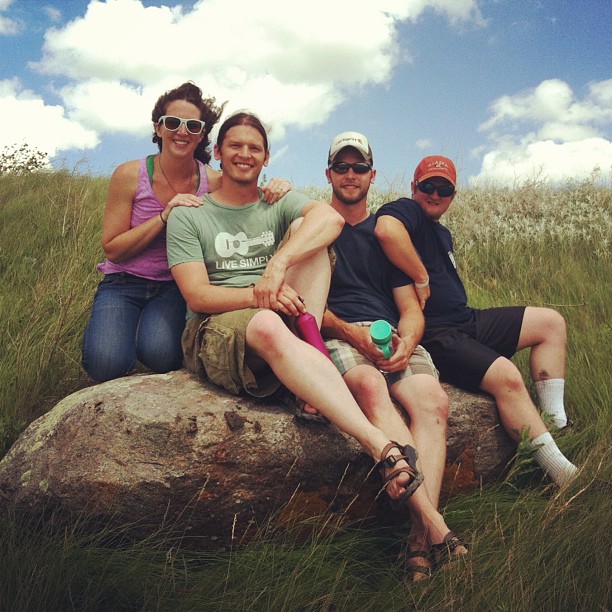
Evan, My future brothers-in-law and I on the hills outside of their family’s cropland (former pastureland in their dairying days!)
While farming in Alaska, I’ve given many farm tours. I don’t know if it’s because of the nature of the farms I’ve worked on, or if it’s because people are so intrigued about the idea of farming in such a seemingly harsh environment. Since I’ve only really farmed here, it doesn’t seem to harsh to me (I don’t really count a stint of farming in Costa Rica–we only planted corn). Either farming at the Alaska Pacific University Farm or at Sun Circle Farm, I’ve found that people love to see what can be grown, what can’t be grown, and most exciting–the methods used for irrigation and season extension.
I’ve given tours to school groups related to water management, sustainability, introductions to farming, Alaskan history, master gardening, and just individuals or families that want to see what the heck is going on. I LOVE giving farm tours.
This summer, working at Sun Circle Farm, a lot of folks just seem to show up randomly throughout the day. I don’t give tours to these folks as I’m either harvesting or, these days, weeding; but there is a little spot in me that yearns to show these folks some of the neatest parts of the farm. It’s like showing off your kid’s medals or trophies, but it doesn’t feel as self-indulgent.
I hadn’t taken a good farm tour myself in quite awhile before heading back to the midwest, and I was really happy when Evan’s mother, Gail, suggested we visit one of the new CSA farms near their home in Valley City, North Dakota called Llama Trax Gardens. If you want, you can check out their website here: http://www.llamatraxgardens.com/index.html
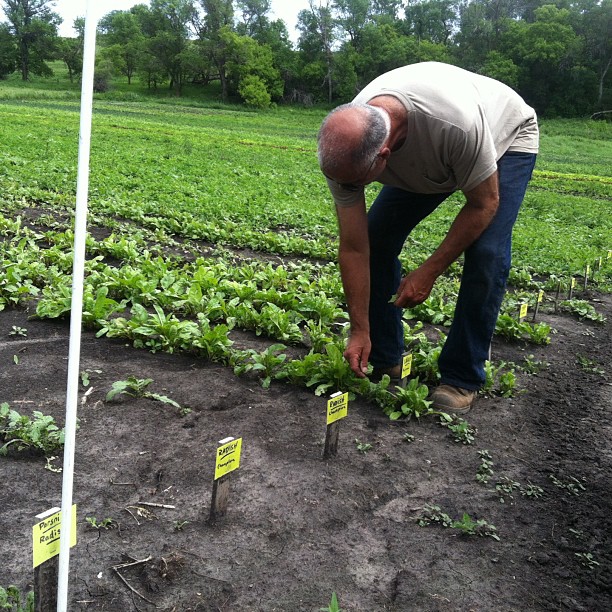
Farmer Scott shows off some of his fancy French radishes.
The visit to this farm was lovely, with a nice personalized tour from the principal farmer, Scott. It was really interesting to see the different methods used in organic agricultural production in the midwest vs. what we do in Alaska.
For one, Scott just does single row crops, he is able to do this mainly because of the huge amount of space that he has! While Alaska has a lot of land, the arable land is few and far between (and not to mention super expensive). We plant most of our crops, two, three, four or five lines per row. Furthermore, Scott doesn’t really have to irrigate his crops, at least he doesn’t have to irrigate using huge irrigation systems of drip line and tape–but then again, he doesn’t live in a veritable desert like Palmer.
Unfortunately, my camera stopped working, but Scott also showed us this nifty seedling planter on a small vintage tractor. two people sit on the tractor, taking turns placing seedlings (grown in soil blocks) into this rotating chain/wheel system and it just plops them into a furrow that is also made by machine! This is a major bonus of single row cropping–not to mention the ease of weeding. I have spent hours upon hours of hand transplanting over the last two seasons because of how densely we plant our crops.
.jpg)
A Farmer and his land.
In Alaska, we also rely so heavily on greenhouses, hoophouses and high (and low!) tunnels, that it was also neat to see how these are utilized on this farm. Scott only uses his hoophouse for early season crops and to house his tender seedlings. He was proud to show off his use of soil blocks (one thing we have in common!).
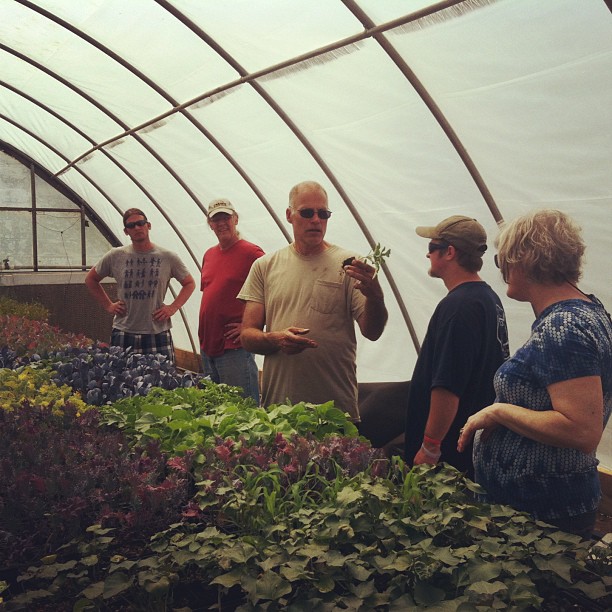
Fun for the whole family!
One of the most interesting things on Llama Trax Gardens farm is the discover of Rhubarb as a cash crop! A local winery makes rhubarb wine, so a few years ago, Scott received hundreds of rhubarb plants from an acquaintance. This easy-as-pie perennial brings in some extra dough for Scott every spring when the winery purchases thousands of pounds to make into wine.
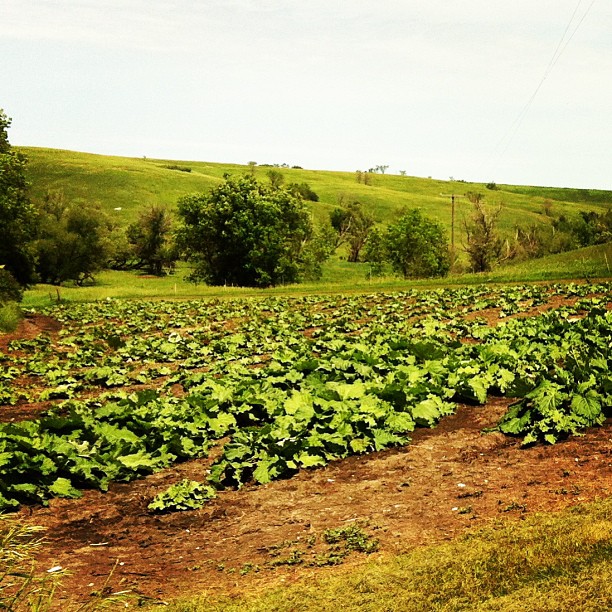
Rhubarb: The new cash crop.
The Alaska Department of Ag. has really been trying to push rhubarb sales in the last year or two–perhaps we should get into the rhubarb wine business! Rhubarb grows throughout most of the summer in Alaska without bolting, making it a special treat for those who remember it as a very early summer crop.
Finally on our tour, we got to visit the farm’s namesake–the llamas! Llamas are some of my favorite farm animals. Scott originally purchased them as part of some agricultural scam that claims that llamas are a great source of income for farmers (I’m unaware of these claims, but others seemed to be up on it). So, these llamas turned out to be not worth the effort of raising for cash purposes, but Scott loves them, and their droppings make a perfect fertilizer for his crops! Like rabbits (and unlike nearly all other animals) llama droppings can be used directly on plants without burning them. It doesn’t have to be composted, aged, or cured before application. Plus, llamas are so cute!
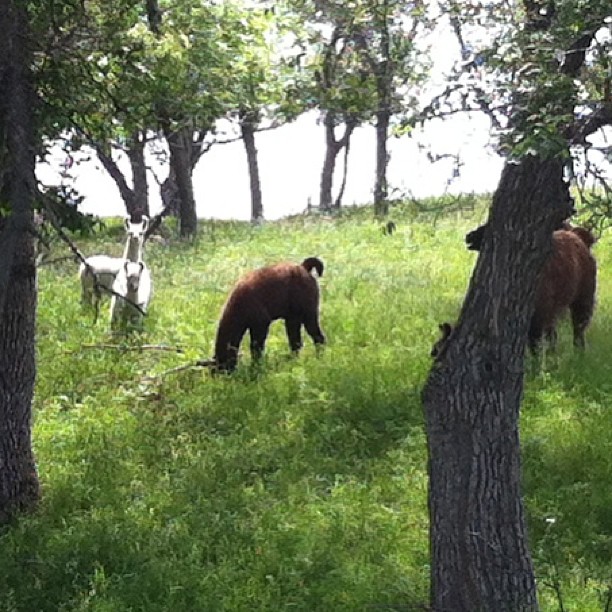
The happy llamas of Llama Trax Gardens.
I’m glad to be back to the familiar farms of Alaska, and I’ve already given one farm tour for Amanda’s mom (Farmer Amanda who I used to work for!) at Sun Circle Farm. it was fun to compare and contrast organic practices in two different places, and I hope to tour some more farms in the not so distant future!
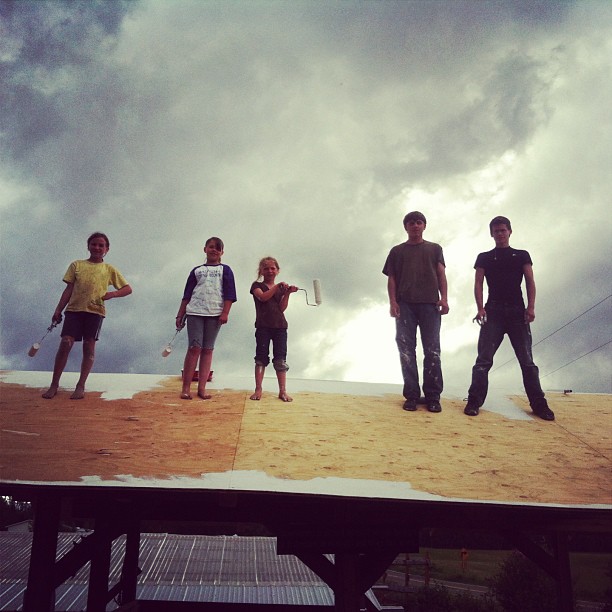
Familiar faces from our helpful painting crew at Sun Circle Farm–it’s great to be back!
Have you enjoyed any fun and informative farm tours recently? or do you have dreams of agrotourism throughout the world? Share your stories with us!
I’ll be back in a couple of weeks with the second part of the ongoing “Living in the Round” saga–I can’t wait!
Sending you peace and love,
Alex, your Rural Farmgirl
P.S. In other botanical news, the famous Titan arum, or corpse flower (it’s giant bloom reeks of rotting meat to attract pollinating flies in the rain forest) is about to bloom at the D.C. Botanical Gardens! It only blooms for a day or two every few years. I’ve been watching the live webcam off and on–it should bloom today or tomorrow! Check it out: http://www.usbg.gov/return-titan


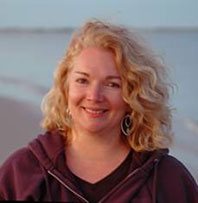


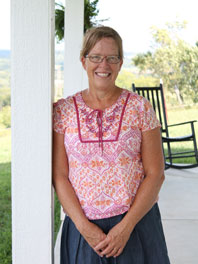
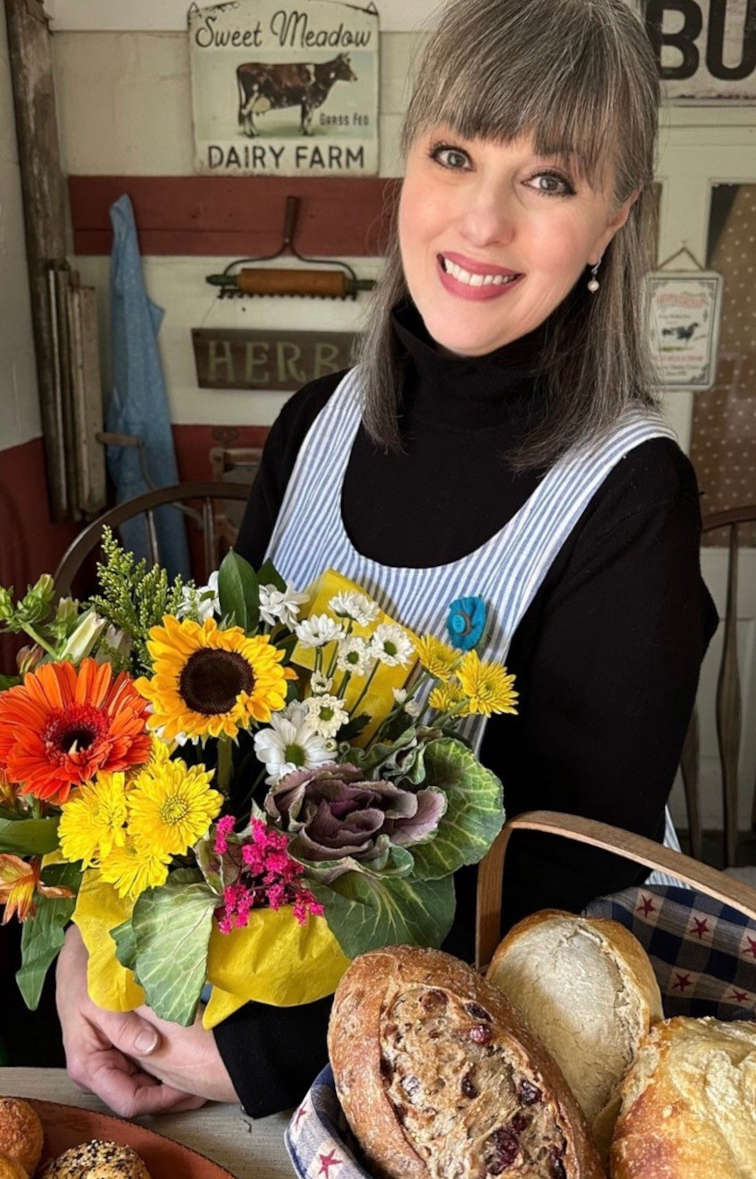
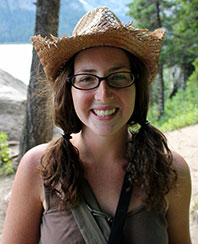
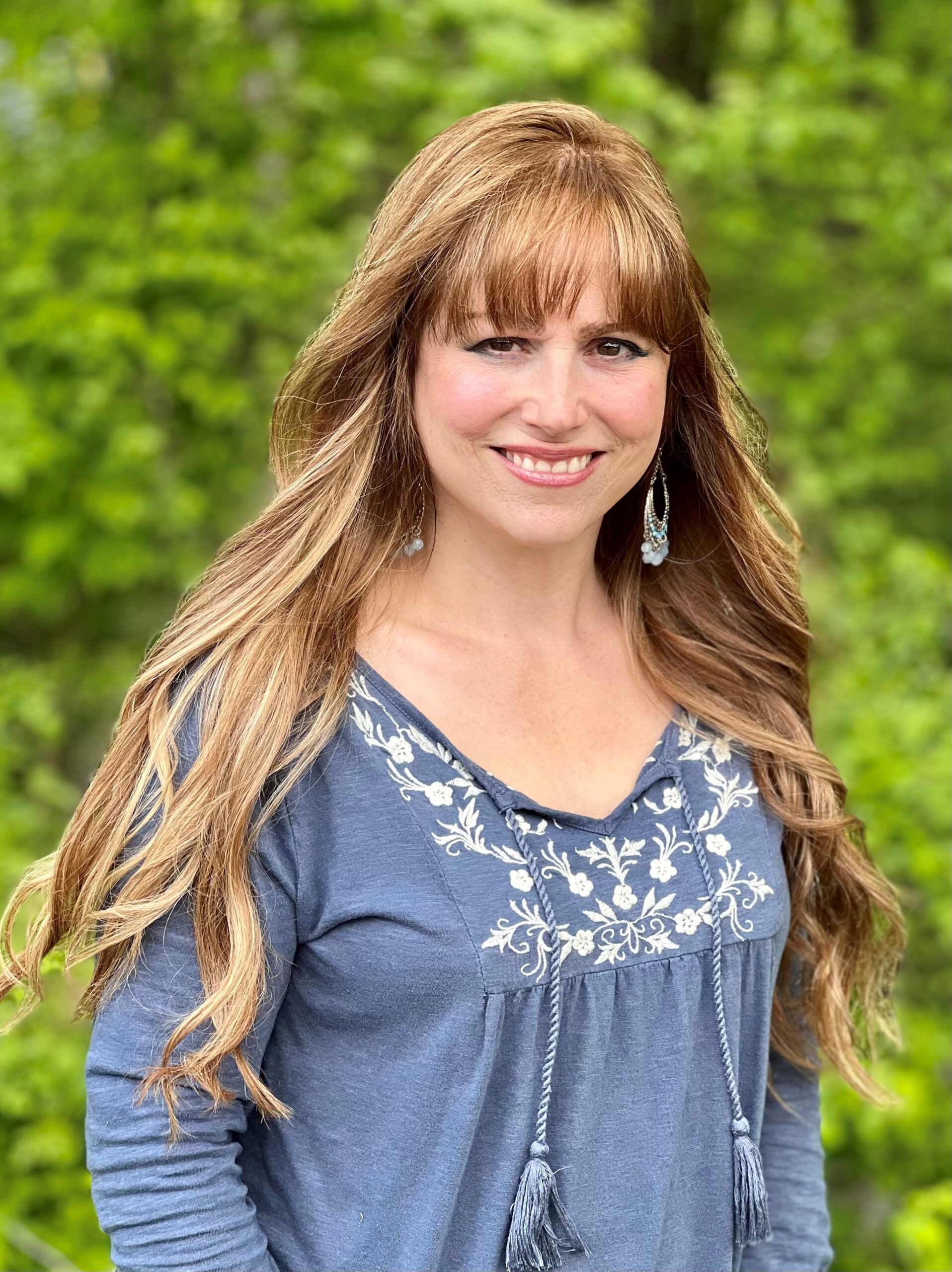
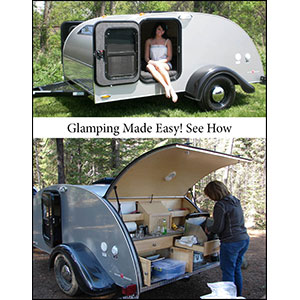

Not having room for crops is something I’m familiar with, as we live in the woods and have very little open land. By the way, goat manure can also be put in the garden fresh without harming the crops. (We have goats, rabbits and chickens so we compost all of their droppings to turn our clay soil into wonderful garden loam. I grow things in raised beds and it works well.
Thanks so much for sharing your adventures at our farm! I only wish I had been home to tour with you, but it sounds like Scott did a great job! Just to clarify – we have never purchased llamas – we have only provided a home for those bought by others who found out there’s not much $$ to be made from them and needed a place for them to go. But they have provided much entertainment and wonderful fertilizer!
This is such a great post! I am trying to learn more about farming because eventually I will end up being a farm wife in MN and these tours give me a little bit more knowledge.